INFICON BPG400 ATM User Manual
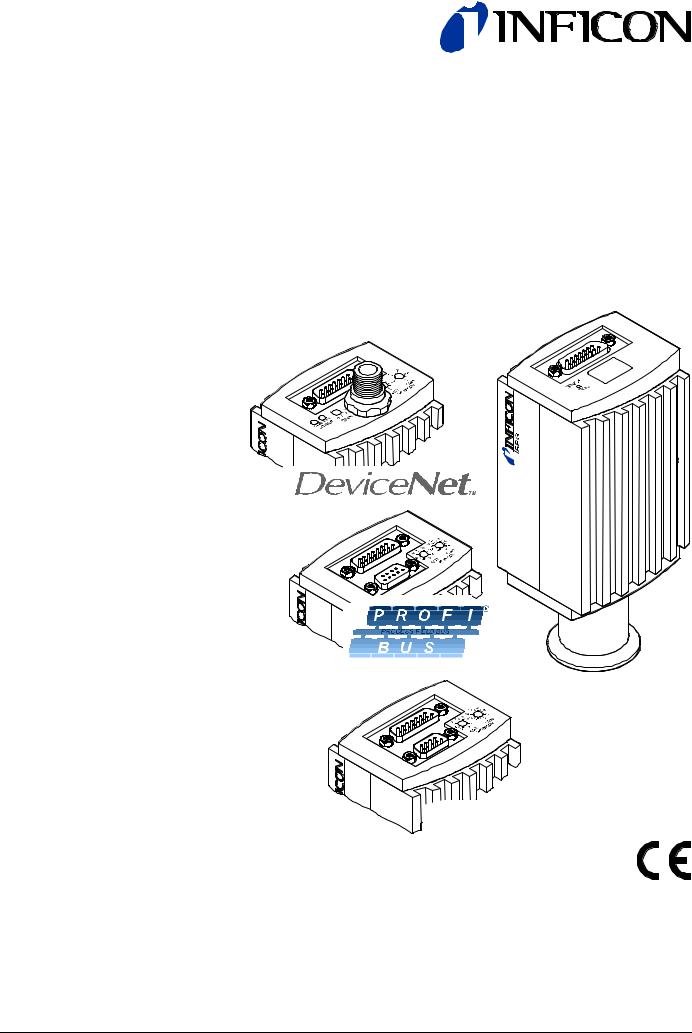
Operating Manual
Bayard-Alpert Pirani Gauge
BPG400
BPG400-SD
BPG400-SP
BPG400-SR
RS485
tina03e1-b (2004-02) |
1 |
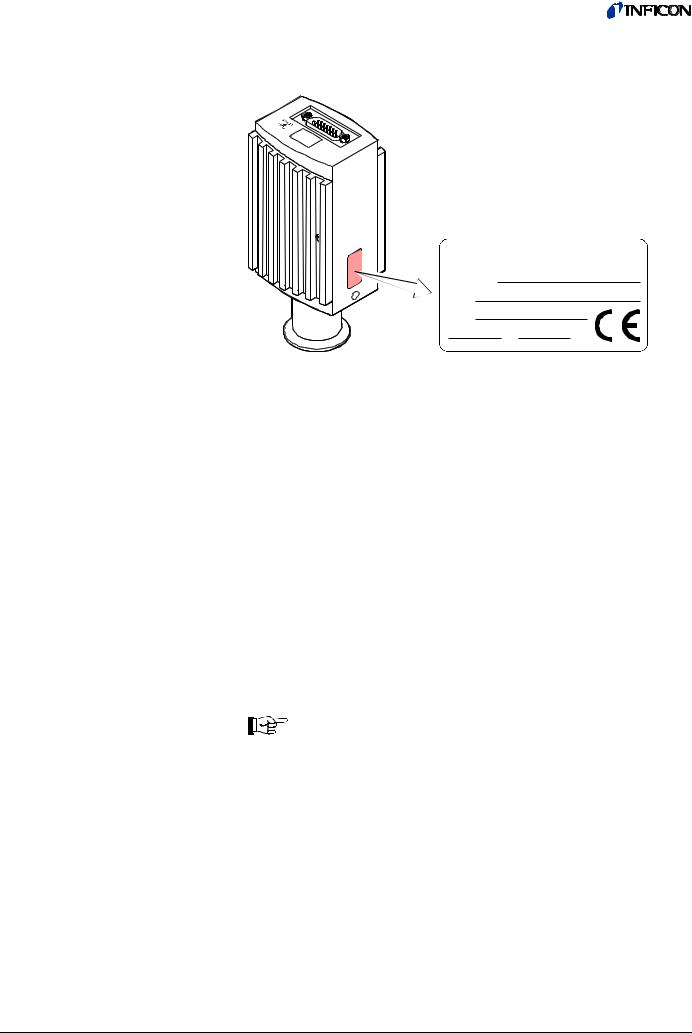
Product Identification
In all communications with INFICON, please specify the information on the product nameplate. For convenient reference copy that information into the space provided below.
INFICON AG, LI-9496 Balzers
Model: |
|
PN: |
|
SN: |
|
V |
W |
Validity
This document applies to products with the following part numbers:
BPG400 (without display)
353-500 (vacuum connection DN 25 ISO-KF) 353-502 (vacuum connection DN 40 CF-R)
BPG400 (with display)
353-501 (vacuum connection DN 25 ISO-KF) 353-503 (vacuum connection DN 40 CF-R)
BPG400-SD (with DeviceNet interface and switching functions)
353-507 (vacuum connection DN 25 ISO-KF) 353-508 (vacuum connection DN 40 CF-R)
BPG400-SP (with Profibus interface and switching functions)
353-505 (vacuum connection DN 25 ISO-KF) 353-506 (vacuum connection DN 40 CF-R)
BPG400-SR (with RS485 interface and switching functions)
353-509 (vacuum connection DN 25 ISO-KF) 353-513 (vacuum connection DN 40 CF-R)
Intended Use
The part number (PN) can be taken from the product nameplate.
If not indicated otherwise in the legends, the illustrations in this document correspond to gauge with part number 353-500. They apply to the other gauges by analogy.
All BPG400 versions are shipped with an instruction sheet (→ |
[8]). BPG400-SD, |
BPG400-SP and BPG400-SR come with a supplementary instruction sheet de- |
|
scribing the fieldbus interfaces and the switching functions (→ |
[9]). |
We reserve the right to make technical changes without prior notice.
The BPG400 gauges have been designed for vacuum measurement of non-flam- mable gases and gas mixtures in a pressure range of 5×10-10 … 1000 mbar.
The gauges can be operated in connection with the INFICON Vacuum Gauge Controller VGC103 or VGC40x or with other control devices.
2 |
tina03e1-b (2004-02) BPG400 v1.om |

Functional Principle
Trademarks
Over the whole measuring range, the gauge has a continuous characteristic curve and its measuring signal is output as logarithm of the pressure.
The gauge functions with a Bayard-Alpert hot cathode ionization measurement system (for p < 2.0×10-2 mbar) and a Pirani measurement system (for
p > 5.5×10-3 mbar). In the overlapping pressure range of
2.0×10-2 … 5.5×10-3 mbar, a mixed signal of the two measurement systems is output. The hot cathode is switched on by the Pirani measurement system only below the switching threshold of 2.4×10-2 mbar (to prevent filament burn-out). It is switched off when the pressure exceeds 3.2×10-2 mbar.
DeviceNet™ |
Open DeviceNet Vendor Association, Inc. |
tina03e1-b (2004-02) BPG400 v1.om |
3 |

Contents
Product Identification |
2 |
|||
Validity |
2 |
|||
Intended Use |
2 |
|||
Functional Principle |
3 |
|||
Trademarks |
3 |
|||
1 |
Safety |
6 |
||
1.1 |
Symbols Used |
6 |
||
1.2 |
Personnel Qualifications |
6 |
||
1.3 |
General Safety Instructions |
7 |
||
1.4 |
Liability and Warranty |
7 |
||
2 |
Technical Data |
8 |
||
3 |
Installation |
13 |
||
3.1 |
Vacuum Connection |
13 |
||
3.1.1 Removing and Installing the Electronics Unit |
14 |
|||
3.1.2 Installing the Optional Extension |
16 |
|||
3.1.3 Using the Optional Baffle |
17 |
|||
3.2 |
Electrical Connection |
19 |
||
3.2.1 Use With INFICON VGC103 or VGC40x Vacuum Gauge Controller |
19 |
|||
3.2.2 Use With Other Controllers |
19 |
|||
3.2.2.1 Making an Individual Sensor Cable |
20 |
|||
3.2.2.2 Making a DeviceNet Interface Cable (BPG400-SD) |
22 |
|||
3.2.2.3 Making a Profibus Interface Cable (BPG400-SP) |
23 |
|||
3.2.2.4 Making a RS485 Interface Cable (BPG400-SR) |
24 |
|||
3.2.3 Using the Optional Power Supply (With RS232C Line) |
25 |
|||
4 |
Operation |
27 |
||
4.1 |
Measuring Principle, Measuring Behavior |
27 |
||
4.2 |
Operational Principle of the Gauge |
28 |
||
4.3 |
Putting the Gauge Into Operation |
29 |
||
4.4 |
Degas |
29 |
||
4.5 |
Display (BPG400) |
30 |
||
4.6 |
RS232C Interface |
31 |
||
4.6.1 Description of the Functions |
31 |
|||
4.6.1.1 |
Output String (Transmit) |
31 |
||
4.6.1.2 |
Input String (Receive) |
33 |
||
4.7 |
DeviceNet Interface (BPG400-SD) |
34 |
||
4.7.1 Description of the Functions |
34 |
|||
4.7.2 |
Operating Parameters |
34 |
||
4.7.2.1 |
Operating Software |
34 |
||
4.7.2.2 |
Node Address Setting |
34 |
||
4.7.2.3 |
Data Rate Setting |
35 |
||
4.7.3 |
Status Lights |
35 |
||
4.8 |
Profibus Interface (BPG400-SP) |
36 |
||
4.8.1 Description of the Functions |
36 |
|||
4.8.2 |
Operating Parameters |
36 |
||
4.8.2.1 |
Operating Software |
36 |
||
4.8.2.2 |
Node Address Setting |
36 |
||
4.9 |
RS485 Interface (BPG400-SR) |
37 |
||
4.9.1 Description of the Functions and Modes |
37 |
|||
4.9.2 |
Data Exchange |
37 |
||
4.9.2.1 |
Operational Parameters |
37 |
||
4.9.2.2 |
Device Address |
38 |
||
4.9.2.3 |
Command Structure (Host) |
38 |
||
4.9.2.4 |
Response Structure |
38 |
||
4.9.2.5 |
Error Messages |
38 |
||
4.9.3 |
Syntax Description |
39 |
||
4.9.3.1 |
Definitions, Legend |
39 |
||
4.9.3.2 |
Commands and Responses |
40 |
||
4.9.4 |
Switching Functions |
42 |
||
4.9.4.1 Programming the Switching Functions |
43 |
|||
4.10 |
|
Switching Functions (BPG400-SD, -SP, -SR) |
44 |
|
4.10.1 Setting the Switching Functions |
44 |
|||
4 |
tina03e1-b (2004-02) BPG400 v1.om |

5 |
Deinstallation |
46 |
||
6 |
Maintenance, Repair |
47 |
||
6.1 |
Maintenance |
47 |
||
6.1.1 |
Cleaning the Gauge |
47 |
||
6.2 |
Adjusting the Gauge |
47 |
||
6.2.1 Adjustment at Atmospheric Pressure |
47 |
|||
6.2.2 |
Zero Point Adjustment |
48 |
||
6.3 |
What to Do in Case of Problems |
49 |
||
6.4 |
Replacing the Sensor |
51 |
||
7 |
Options |
52 |
||
8 |
Spare Parts |
52 |
||
9 |
Storage |
52 |
||
10 |
|
Returning the Product |
53 |
|
11 |
|
Disposal |
53 |
|
Appendix |
54 |
|||
A: |
Relationship Output Signal – Pressure |
54 |
||
B: |
|
Gas Type Dependence |
55 |
|
C: |
|
Literature |
57 |
|
Declaration of Contamination |
58 |
|||
For cross-references within this document, the symbol (→ XY) is used, for crossreferences to further documents and data sources, the symbol (→ [Z]).
tina03e1-b (2004-02) BPG400 v1.om |
5 |
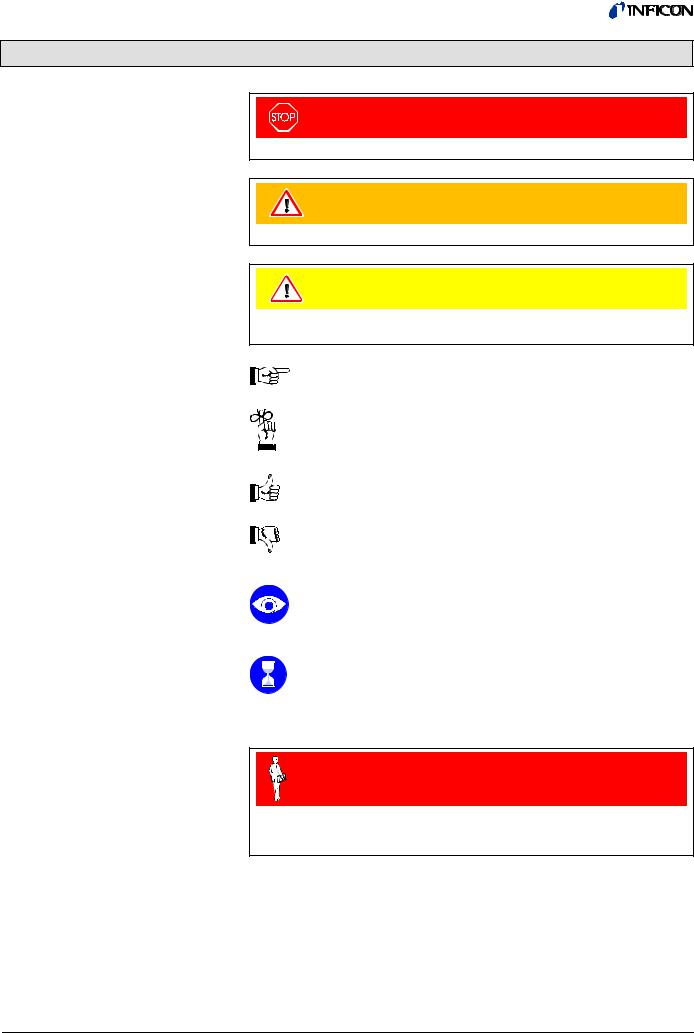
1 Safety
1.1 Symbols Used
DANGER
Information on preventing any kind of physical injury.
WARNING
Information on preventing extensive equipment and environmental damage.
Caution
Information on correct handling or use. Disregard can lead to malfunctions or minor equipment damage.
Notice
Hint, recommendation
The result is O.K.
The result is not as expected
Optical inspection
Waiting time, reaction time
1.2 Personnel Qualifications
Skilled personnel
All work described in this document may only be carried out by persons who have suitable technical training and the necessary experience or who have been instructed by the end-user of the product.
6 |
tina03e1-b (2004-02) BPG400 v1.om |

1.3General Safety Instructions
1.4 Liability and Warranty
•Adhere to the applicable regulations and take the necessary precautions for the process media used.
Consider possible reactions between the materials (→ 11) and the process media.
Consider possible reactions of the process media (e.g. explosion) due to the heat generated by the product.
•Adhere to the applicable regulations and take the necessary precautions for all work you are going to do and consider the safety instructions in this document.
•Before beginning to work, find out whether any vacuum components are contaminated. Adhere to the relevant regulations and take the necessary precautions when handling contaminated parts.
Communicate the safety instructions to all other users.
INFICON assumes no liability and the warranty becomes null and void if the enduser or third parties
•disregard the information in this document
•use the product in a non-conforming manner
•make any kind of interventions (modifications, alterations etc.) on the product
•use the product with accessories not listed in the corresponding product documentation.
The end-user assumes the responsibility in conjunction with the process media used.
tina03e1-b (2004-02) BPG400 v1.om |
7 |
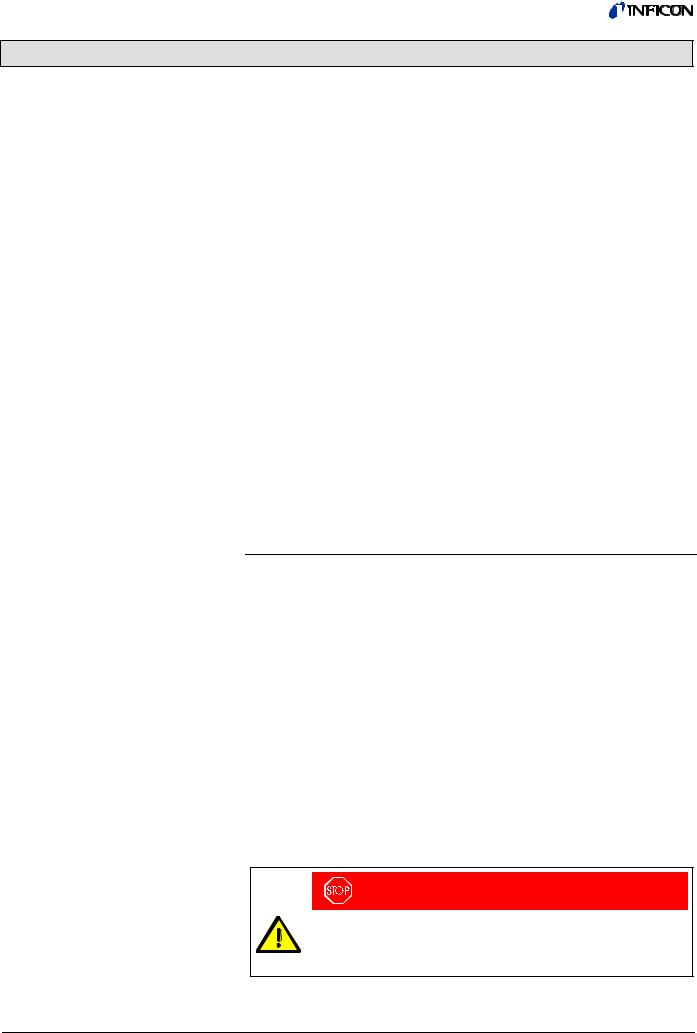
2 Technical Data
Measurement
Emission
Degas
Output signal
Display (BPG400)
Power supply
Measuring range (air, N2, O2) |
5×10-10 … 1000 mbar, continuous |
Accuracy |
15% of reading in the range of |
|
10-8 … 10-2 mbar |
|
(after 5 min stabilization) |
Repeatability |
5% of reading in the range of |
|
10-8 … 10-2 mbar |
|
(after 5 min stabilization) |
Gas type dependence |
→ Appendix B |
Switching on threshold |
2.4×10-2 mbar |
Switching off threshold |
3.2×10-2 mbar |
Emission current |
|
p ≤7.2×10-6 mbar |
5 mA |
7.2×10-6 mbar <p <3.2×10-2 mbar |
25 µA |
Emission current switching |
7.2×10-6 mbar |
25 µA 5 mA |
|
5 mA 25 µA |
3.2×10-5 mbar |
Degas emission current |
≈16 mA (Pdegas ≈4 W) |
(p <7.2×10-6 mbar) |
|
Control input signal |
0 V/+24 VDC, active high |
|
(control via RS232 → 31) |
Duration |
max. 3 min, followed by automatic stop |
In degas mode, BPG400 gauges keep supplying measurement values, however their tolerances may be higher than during normal operation.
Output signal (measuring signal) |
0 … +10 V |
Measuring range |
0.774 V (5×10-10 mbar) |
|
… +10 V (1000 mbar) |
Relationship voltage-pressure |
logarithmic, 0.75 V/decade |
|
(→ Appendix A) |
Error signal |
<0.3 V/0.5 V (→ 49) |
Minimum loaded impedance |
10 kΩ |
Display panel |
LCD matrix, 32×16 pixels, |
|
with background illumination |
Dimensions |
16.0 mm × 11.2 mm |
Pressure units (pressure p) |
mbar (default), Torr, Pa |
|
(selecting the pressure unit → 31) |
DANGER
The gauge must only be connected to power supplies, instruments or control devices that conform to the requirements of a grounded extralow voltage (SELV-E according to EN 61010). The connection to the gauge has to be fused (INFICON-controllers fulfill these requirements).
8 |
tina03e1-b (2004-02) BPG400 v1.om |

|
Operating voltage at the gauge |
+24 VDC (20 … 28 VDC) 1) |
||
|
|
|
|
ripple max. 2 Vpp |
|
Power consumption |
|
||
|
|
|
Standard |
≤0.5 A |
|
|
|
Degas |
≤0.8 A |
|
|
|
Emission start (<200 ms) |
≤1.4 A |
|
Power consumption |
|
||
|
|
|
BPG400 |
≤16 W |
|
|
|
BPG400-SD, -SP, -SR |
≤18 W |
|
Fuse necessary |
1.25 AT |
||
|
|
|
BPG400-SD requires an additional, separate power supply for the |
|
|
|
|
||
|
|
|
||
|
|
|
DeviceNet interface (→ |
22). |
|
Supply voltage at the DeviceNet con- |
|||
|
nector, (Pin 2 and Pin 3) |
+24 VDC (+11 … 25 VDC) |
||
|
Power consumption |
<2 W |
||
The gauge is protected against reversed polarity of the supply voltage.
Sensor cable connection
For reasons of compatibility, the expression "sensor cable" is used for all BPG400 versions in this document, although the pressure reading of the gauges with fieldbus interface (BPG400-SD, BPG400-SD and BPG400-SR) is normally transmitted via the corresponding bus.
Electrical connector BPG400 BPG400-SD, -SP, -SR
Cable for BPG400 Analog values only Without degas function
Analog values With degas function
Analog values With degas function
And RS232C interface Cable for BPG400-SD, -SP, -SR
Max. cable length (supply voltage 24 V 1)) Analog and fieldbus operation
D-Sub,15 pins, male
→20
→21
4 conductors plus shielding
5 conductors plus shielding
7 conductors plus shielding
depending on the functions used, max. 15 conductors plus shielding
≤35 m, conductor cross-section 0.25 mm² ≤50 m, conductor cross-section 0.34 mm² ≤100 m, conductor cross-section 1.0 mm²
RS232C operation |
≤30 m |
Gauge identification |
42 kΩ resistor between Pin 10 (sensor |
|
cable) and GND |
Switching functions |
|
BPG400 |
none |
BPG400-SD, -SP, -SR |
2 (setpoints A and B) |
Adjustment range |
1×10-9 mbar … 100 mbar |
|
Setpoints adjustable via potentiometers |
|
(setpoints A and B), one floating, nor- |
|
mally open relay contact per setpoint |
|
(→ 21, 44) |
|
Adjusting the setpoints via field bus is |
|
described in the corresponding bus sec- |
|
tions. |
Relay contact rating |
≤60 V |
Voltage |
|
Current |
≤0.5 ADC |
1)Measured at sensor cable connector (consider the voltage drop as function of the sensor cable length).
tina03e1-b (2004-02) BPG400 v1.om |
9 |

RS232C interface
DeviceNet interface (BPG400-SD)
Profibus interface (BPG400-SP)
Data rate |
9600 Baud |
|
|
|
|
Data format |
binary |
|
|
|
|
|
8 data bits |
|
|
|
|
|
one stop bit |
|
|
|
|
|
no parity bit |
|
|
|
|
|
no handshake |
|
|
|
|
Connections (sensor cable connector) |
Pin 13 |
|
|
|
|
TxD (Transmit Data) |
|
|
|
||
RxD (Receive Data) |
Pin 14 |
|
|
|
|
GND |
Pin |
5 |
|
|
|
(Function and communication protocol of the RS232C interface → |
31) |
|
|||
Fieldbus name |
DeviceNet |
|
|
|
|
Standard applied |
→ |
[6] |
|
|
|
Communication protocol, data format |
→ |
[1], [4] |
|
|
|
Interface, physical |
CAN bus |
|
|
|
|
Data rate (adjustable via "RATE" |
125 kBaud |
|
|
|
|
switch) |
250 kBaud |
|
|
|
|
|
500 kBaud |
|
|
|
|
|
"P" (125 kBaud, 250 kBaud, 500 kBaud |
||||
|
programmable via DeviceNet |
||||
|
(→ |
[1]) |
|
|
|
Node address (MAC ID) |
0 … 63dec |
|
|
|
|
(Adjustable via "ADDRESS", "MSD", |
"P" (0 … 63 programmable via |
||||
"LSD" switches) |
DeviceNet, → |
[1]) |
|
|
|
DeviceNet connector |
Micro-Style, 5 pins, male |
|
|
||
Cable |
Shielded, special DeviceNet cable, |
||||
|
5 conductors (→ |
22 and |
[4]) |
|
|
Cable length, system wiring |
According to DeviceNet specifications |
||||
|
(→ |
[6], [4]) |
|
|
|
Fieldbus name |
Profibus |
|
|
|
|
Standard applied |
→ |
[7] |
|
|
|
Communication protocol data format |
→ |
[10], [7] |
|
|
|
Interface, physical |
RS485 |
|
|
|
|
Data rate |
≤12 MBaud (→ |
[10]) |
|
|
|
Node address |
|
|
|
|
|
Local |
|
|
|
|
|
(Adjustable via hexadecimal |
|
|
|
|
|
"ADDRESS", "MSD", "LSD" |
|
|
|
|
|
switches) |
00 … 7Dhex (0 … 125dec) |
|
|
||
Via Profibus |
|
|
|
|
|
(hexadecimal "ADDRESS" switches |
|
|
|
|
|
set to >7dhex (>125dec)) |
00 … 7Dhex (0 … 125dec) |
|
|
||
Profibus connection |
D-Sub, 9 pins, female |
|
|
||
Cable |
Shielded, special Profibus cable |
||||
|
(→ |
23 and |
[5]) |
|
|
Cable length, system wiring |
According to Profibus specifications |
||||
|
(→ |
[7], [5]) |
|
|
|
10 |
tina03e1-b (2004-02) BPG400 v1.om |

RS485 interface (BPG400-SR)
Vacuum
Weight
Ambiance
Fieldbus name |
RS485 |
|
|
Data rate |
300 … 28'800 Baud |
|
|
Device address |
|
|
|
(Adjustable via hexadecimal |
|
|
|
"ADDRESS", "MSD", "LSD" switches) |
00 … 7Fhex (0 … 127dec), (→ |
38) |
|
RS485 connection |
D-Sub, 9 pins, male |
|
|
Cable |
shielded RS485 cable (→ |
24) |
|
Cable length |
≤100m |
|
|
Materials exposed to vacuum |
stainless steel |
|
|
Housing, supports, screens |
|
|
|
Feedthroughs |
NiFe, nickel plated |
|
|
Insulator |
glass |
|
|
Cathode |
iridium, yttrium oxide (Y2O3) |
|
|
Cathode holder |
molybdenum |
|
|
Pirani element |
tungsten, copper |
|
|
Internal volume |
≤24 cm3 |
|
|
DN 25 ISO-KF |
|
|
|
DN 40 CF-R |
≤34 cm3 |
|
|
Pressure max. |
2 bar (absolute) |
|
|
Part number |
|
|
|
353-500, 353-501 |
≈290 g |
|
|
353-502, 353-503 |
≈550 g |
|
|
353-505, 353-507, 353-509 |
≈430 g |
|
|
353-506, 353-508, 353-513 |
≈695 g |
|
|
Admissible temperatures |
|
|
|
Storage |
-20 … 70 °C |
|
|
Operation |
0 … 50 °C |
|
|
Bakeout |
+150 °C (without electronics unit or with |
|
|
|
bakeout extension → 16) |
|
|
Relative humidity |
|
|
|
(year's mean / during 60 days) |
≤65 / 85% (no condensation) |
|
|
Use |
indoors only |
|
|
|
altitude up to 2000 m NN |
|
|
Type of protection |
IP 30 |
|
|
tina03e1-b (2004-02) BPG400 v1.om |
11 |

Dimensions |
Part number |
Part number |
|
||
|
353-500 |
353-502 |
|
353-501 |
353-503 |
|
353-505 |
353-506 |
|
353-509 |
353-513 |
|
(353-507) 1) |
(353-508) 1) |
|
4-40UNC 2B |
4-40UNC 2B |
DN 25 ISO-KF
DN 40 CF-R
1)Gauges with DeviceNet connector are 14 mm longer.
The other dimensions of housing and vacuum connection are identical.
Part number 353-507 353-508
12 |
tina03e1-b (2004-02) BPG400 v1.om |

3 Installation
3.1 Vacuum Connection
Procedure
DANGER
Caution: overpressure in the vacuum system >1 bar
Injury caused by released parts and harm caused by escaping process gases can result if clamps are opened while the vacuum system is pressurized.
Do not open any clamps while the vacuum system is pressurized. Use the type of clamps which are suited to overpressure.
DANGER
The gauge must be electrically connected to the grounded vacuum chamber. This connection must conform to the requirements of a protective connection according to EN 61010:
•CF connections fulfill this requirement
•For gauges with a KF vacuum connection, use a conductive metallic clamping ring.
Caution
Caution: vacuum component
Dirt and damages impair the function of the vacuum component.
When handling vacuum components, take appropriate measures to ensure cleanliness and prevent damages.
The gauge may be mounted in any orientation. To keep condensates and particles from getting into the measuring chamber, preferably choose a horizontal to upright position. See dimensional drawing for space requirements (→ 12).
•The gauge is supplied with a built-in grid. For potentially contaminating applications and to protect the electrodes against light and fast charged particles,
installation (→ 17) of the optional baffle is recommended (→ 52).
•The sensor can be baked at up to 150 °C. At temperatures exceeding 50 °C,
the electronics unit has to be removed (→ 14) or an extension (Option → 52) has to be installed (→ 16).
Remove the protective lid.
The protective lid will be needed for maintenance.
tina03e1-b (2004-02) BPG400 v1.om |
13 |
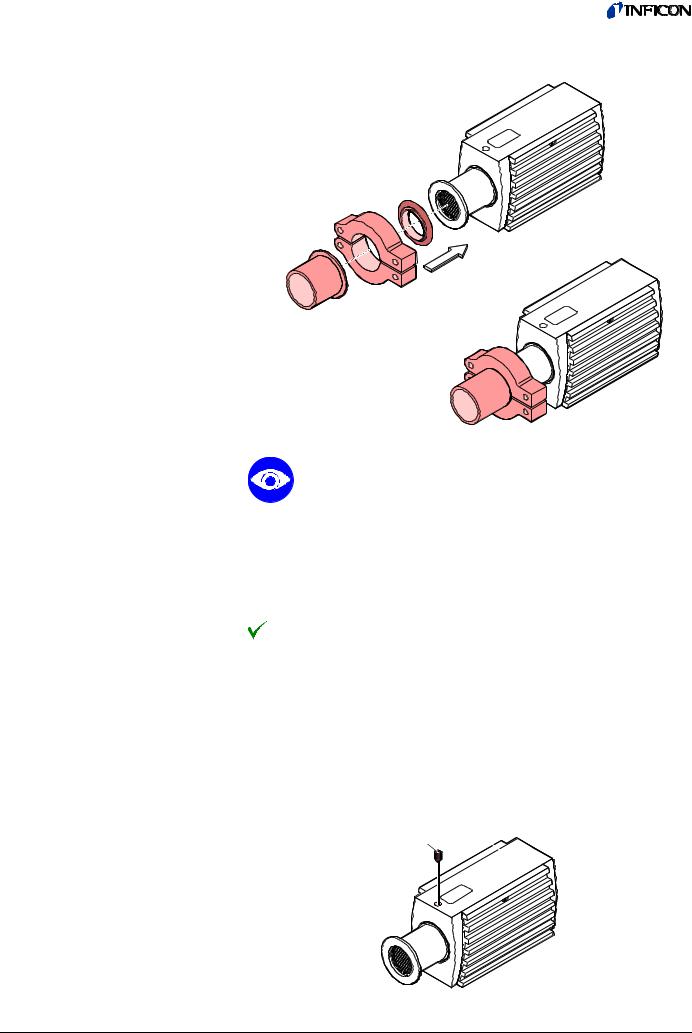
Make the flange connection to the vacuum system, preferably without applying vacuum grease.
When installing the gauge, make sure that the area around the connector is accessible for the tools required for adjustment while the gauge is mounted (→ 44, 47).
When installing the gauge, allow for installing/deinstalling the connectors and accommodation of cable loops.
If you are using a gauge with display, make sure easy reading of the display is possible.
The gauge is now installed.
3.1.1Removing and Installing the Electronics Unit
Required tools / material |
• Allen key, size 2.5 mm |
Removing the electronics unit
Unscrew the hexagon socket set screw (1) on the side of the electronics unit (2).
2
1
14 |
tina03e1-b (2004-02) BPG400 v1.om |
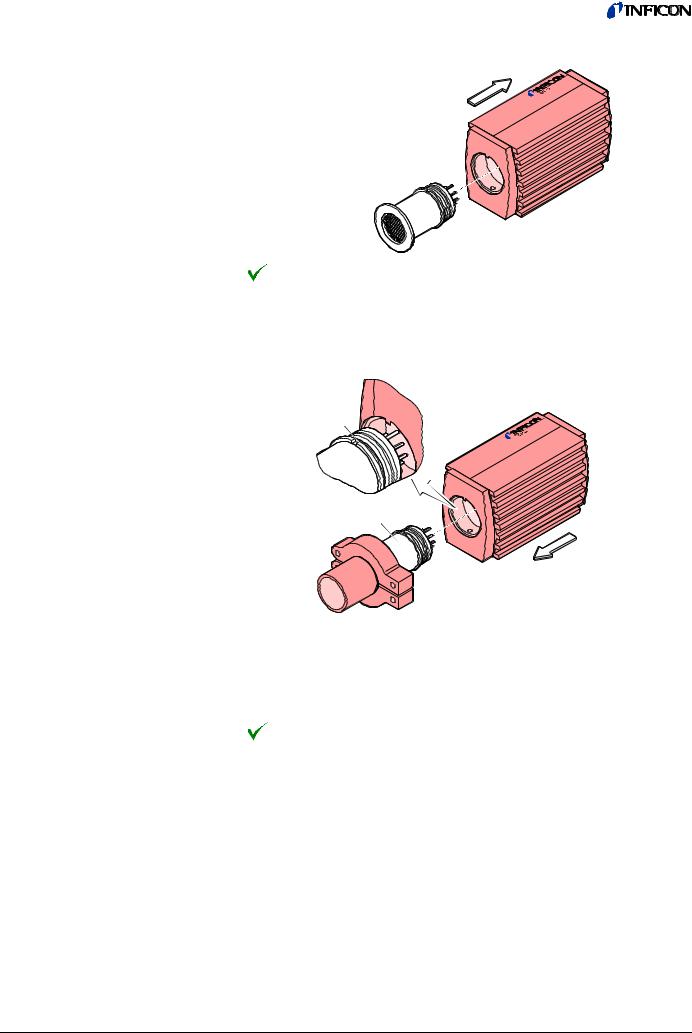
Remove the electronics unit without twisting it.
Removal of the electronics unit is completed.
Installing the electronics unit
Place the electronics unit on the sensor (3) (be careful to correctly align the pins and notch (4)).
4
3
Slide the electronics unit in to the mechanical stop and lock it with the hexagon socket set screw (1).
The electronics unit is now installed.
tina03e1-b (2004-02) BPG400 v1.om |
15 |

3.1.2Installing the Optional Extension
Bakeout area
With the optional extension (→ 52) the sensor can also be baked during operation at temperatures up to 150 °C (only at p<10-2 mbar because at high temperatures, the accuracy of the Pirani sensor decreases).
Caution
Caution: rising heat
The electronics unit of gauges that are installed vertically, above the source of heat can be damaged through rising heat even with an installed extension.
123
 Bakeout area
Bakeout area
Required tools / material
Procedure
When installing the extension, make sure that the area around the connector is accessible for the tools required for adjustment while the gauge is mounted (→ 44, 47).
When installing the gauge, allow for installing/deinstalling the connectors and accommodation of cable loops.
If you are using a gauge with display, ensure easy reading of the display.
• Extension (→ 52)
•Allen key, size 2.5 mm
•Allen key, size 1.5 mm
Remove the electronics unit (2) (→ 14).
Slide the sensor (3) into the extension (6) to the mechanical stop (be careful to correctly position the pins and notch (4)).
Secure the sensor with the hex socket set screws (7) using an Allen key, size 1.5 mm.
2
4a
4 |
6 |
1 |
3 |
|
|
|
7 |
|
16 |
tina03e1-b (2004-02) BPG400 v1.om |
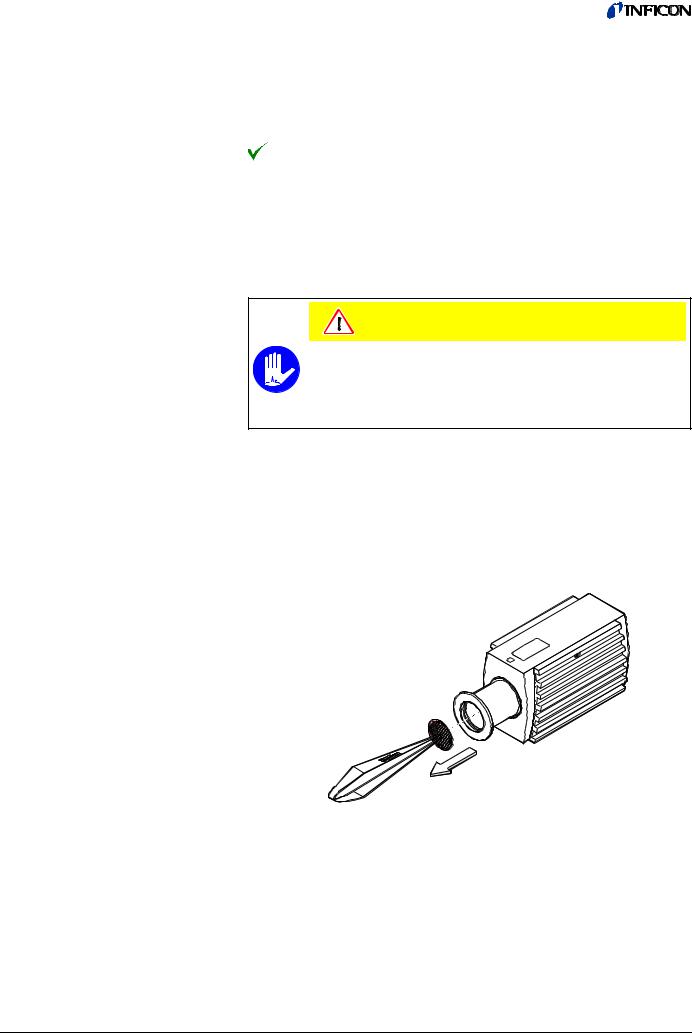
3.1.3Using the Optional Baffle
Installing/deinstalling the baffle
Slide the electronics unit (2) in to the mechanical stop (be careful to correctly align the pins and notch (4a)).
Secure the electronics unit (2) with the hex socket set screw (1) using an Allen key, size 2.5 mm.
The extension is now installed.
In severely contaminating processes and to protect measurement electrodes optically against light and fast charged particles, replacement of the built-in grid by the optional baffle (→ 52) is recommended.
The optional baffle will be installed/deinstalled at the sensor opening of the deinstalled gauge (Deinstallation gauge → 46).
Caution
Caution: dirt sensitive area
Touching the product or parts thereof with bare hands increases the desorption rate.
Always wear clean, lint-free gloves and use clean tools when working in this area.
Required tools / material |
• |
Baffle (→ 52) |
|
• |
Pointed tweezers |
|
• |
Pin (e.g. pencil) |
|
• |
Screwdriver No 1 |
Installation |
|
Carefully remove the grid with tweezers. |
|
|
tina03e1-b (2004-02) BPG400 v1.om |
17 |
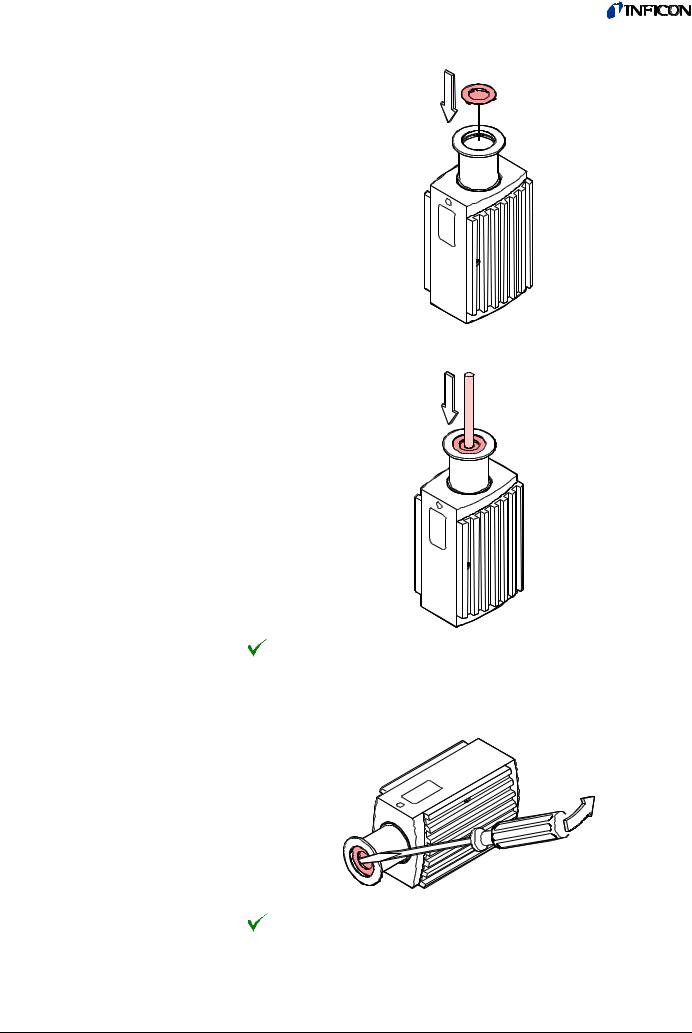
Carefully place the baffle onto the sensor opening.
Using a pin, press the baffle down in the center until it catches.
|
The baffle is now installed (Installation of the gauge → 13). |
Deinstallation |
Using a pin, press the baffle down in the center until it catches. |
The new baffle is now installed (Installation of the gauge → 13).
18 |
tina03e1-b (2004-02) BPG400 v1.om |
